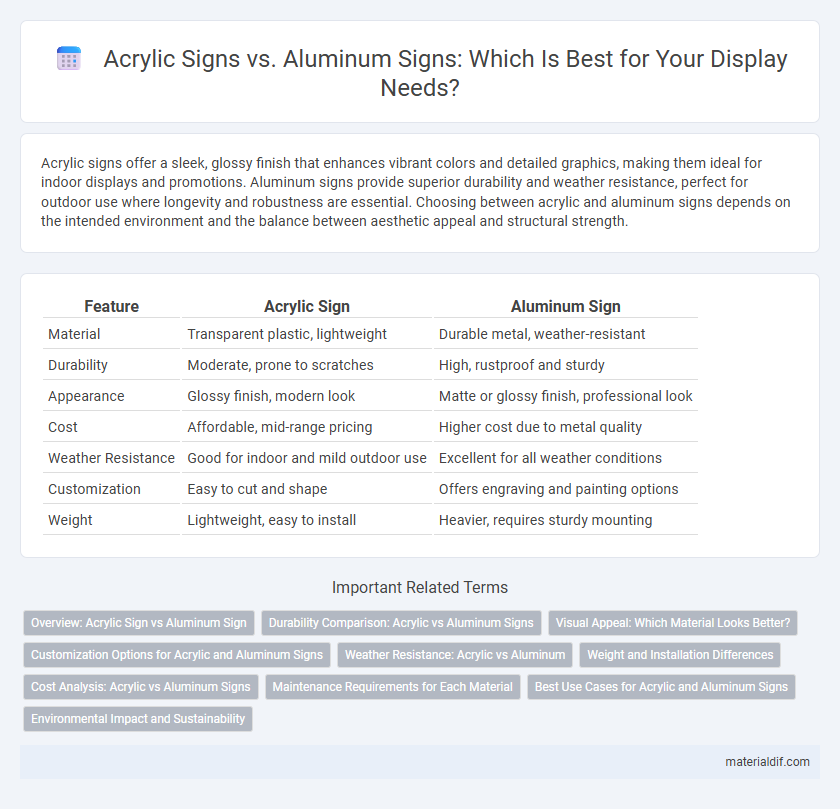Acrylic signs offer a sleek, glossy finish that enhances vibrant colors and detailed graphics, making them ideal for indoor displays and promotions. Aluminum signs provide superior durability and weather resistance, perfect for outdoor use where longevity and robustness are essential. Choosing between acrylic and aluminum signs depends on the intended environment and the balance between aesthetic appeal and structural strength.
Table of Comparison
| Feature | Acrylic Sign | Aluminum Sign |
|---|---|---|
| Material | Transparent plastic, lightweight | Durable metal, weather-resistant |
| Durability | Moderate, prone to scratches | High, rustproof and sturdy |
| Appearance | Glossy finish, modern look | Matte or glossy finish, professional look |
| Cost | Affordable, mid-range pricing | Higher cost due to metal quality |
| Weather Resistance | Good for indoor and mild outdoor use | Excellent for all weather conditions |
| Customization | Easy to cut and shape | Offers engraving and painting options |
| Weight | Lightweight, easy to install | Heavier, requires sturdy mounting |
Overview: Acrylic Sign vs Aluminum Sign
Acrylic signs offer a sleek, glossy finish with excellent clarity and vibrant color options, making them ideal for indoor displays and branding that require a modern aesthetic. Aluminum signs are highly durable, weather-resistant, and lightweight, suitable for outdoor use where long-lasting performance and rust-free properties are essential. Both materials provide versatile signage solutions, but acrylic emphasizes visual appeal while aluminum prioritizes strength and longevity.
Durability Comparison: Acrylic vs Aluminum Signs
Acrylic signs offer excellent weather resistance and vibrant color retention but can be prone to scratching and cracking under heavy impact. Aluminum signs excel in durability with superior resistance to rust, corrosion, and physical damage, making them ideal for outdoor and industrial environments. For long-term signage needs requiring toughness and resilience, aluminum signs typically outperform acrylic in durability.
Visual Appeal: Which Material Looks Better?
Acrylic signs offer a sleek, glossy finish with vibrant color depth that enhances visual appeal, making them ideal for high-end branding and indoor displays. Aluminum signs provide a more durable, matte look resistant to weathering, suitable for outdoor use but typically less vibrant than acrylic. For striking, polished aesthetics, acrylic is often preferred, whereas aluminum excels in longevity and rugged environments.
Customization Options for Acrylic and Aluminum Signs
Acrylic signs offer extensive customization options including vibrant color printing, varying thicknesses, and the ability to create intricate laser-cut shapes with a glossy, glass-like finish. Aluminum signs provide durability with options for brushed, matte, or reflective finishes, and support full-color digital printing, embossing, and custom shapes suitable for outdoor use. Both materials accommodate tailored sizes and mounting solutions, but acrylic excels in aesthetic versatility while aluminum is preferred for rugged, long-lasting signage.
Weather Resistance: Acrylic vs Aluminum
Acrylic signs exhibit excellent weather resistance with strong UV protection and moisture resistance, maintaining color vibrancy and structural integrity in harsh sunlight and rain. Aluminum signs offer superior durability against extreme weather conditions, including heavy rain, wind, and temperature fluctuations, due to their rust-proof and corrosion-resistant properties. For long-term outdoor use in areas with severe weather, aluminum signs generally provide more reliable weather resistance, while acrylic signs perform well in moderate conditions.
Weight and Installation Differences
Acrylic signs are significantly lighter than aluminum signs, making them easier to handle and install, especially for indoor applications. The lightweight nature of acrylic allows for versatile mounting options such as adhesive tapes or lightweight standoffs, reducing the need for heavy-duty hardware. Aluminum signs, while more durable, require sturdier supports and anchors due to their weight, making installation more labor-intensive and time-consuming.
Cost Analysis: Acrylic vs Aluminum Signs
Acrylic signs generally have a higher upfront cost compared to aluminum signs due to the material's clarity and premium finish, with prices ranging from $30 to $100 per square foot versus $20 to $60 for aluminum. Acrylic offers superior aesthetic appeal and customization options, often justifying the additional expense for businesses seeking a high-end look. Aluminum signs provide durability and cost-efficiency, making them ideal for budget-conscious projects or outdoor use where weather resistance is critical.
Maintenance Requirements for Each Material
Acrylic signs require regular cleaning with non-abrasive cleaners to prevent surface scratches and maintain clarity, while aluminum signs demand minimal maintenance, primarily involving occasional washing to remove dirt and prevent corrosion. Acrylic is more prone to damage from harsh chemicals and UV exposure, necessitating protective coatings or indoor placement for longevity. Aluminum signs offer superior durability in outdoor environments due to their rust-resistant properties, making them ideal for long-term use with less frequent upkeep.
Best Use Cases for Acrylic and Aluminum Signs
Acrylic signs are ideal for indoor applications requiring a sleek, high-gloss finish, such as retail displays, office nameplates, and directional signage, due to their clarity and ability to showcase vibrant colors. Aluminum signs offer superior durability and weather resistance, making them perfect for outdoor use in environments like parking lot signs, building markers, and traffic signage. Choosing between acrylic and aluminum depends on whether the signage demands aesthetic appeal and indoor functionality or ruggedness and long-term outdoor performance.
Environmental Impact and Sustainability
Acrylic signs are derived from petrochemicals, making them less biodegradable and contributing to microplastic pollution, whereas aluminum signs are highly recyclable and have a lower environmental footprint over their lifecycle. The production of aluminum, while energy-intensive, benefits from an established recycling infrastructure that significantly reduces raw material extraction and energy consumption compared to acrylic manufacturing. Choosing aluminum signage supports circular economy practices by enabling material recovery and reuse, enhancing sustainability in commercial and environmental contexts.
Acrylic Sign vs Aluminum Sign Infographic

 materialdif.com
materialdif.com